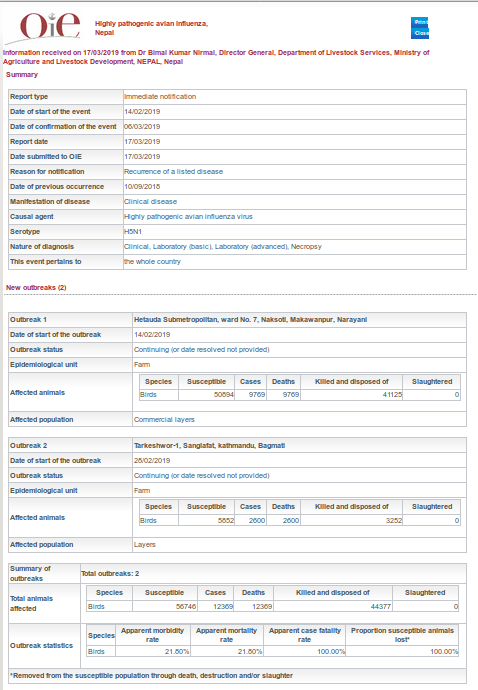#13,941
While H5N1 reports have been on the decline globally for the past several years - largely supplanted by H5N8 and H5N6 - over the past few months we've seen a bit of a resurgence of this venerable H5 subtype on the Indian Subcontinent.
Some recent blogs include:
India: New Media Reports Of Avian Flu In Poultry & Crows - Jharkhand
India: More H5N1 Bird Deaths At Bihar Zoo
India: Patna Zoo Closed Due To H5N1 Peacock Deaths
There's been a northward movement of H5N1 reports since December along the Eastern part of India, likely due to migratory birds.
For the past several days there have been vague reports of a bird flu outbreak in Nepal, which has been attributed by the media to H5N1 and/or H9N2. Overnight this report, from the Kathmandu Post, was published:
Bird flu detected in two Kathmandu poultry farms
KathmanduMar 18, 2019-
Bird flu has been detected in two poultry farms at Tarkeshwar Municipality in Kathmandu. The infectious disease, medically known as H5N1 influenza virus, was detected and confirmed in the chickens being reared in the farms belonging to Shyam Sundar Basnet of Basnet Tole in Tarkeshwor-7 and Shyam Kumar Basnet, chief of Department of Livestock Services Dr Jaya Prakash Raya said.
According to him, as many as 28,000 chickens were being culled after they were tested positive for the infection. Dr Raya said the infection that causes severe respiratory diseases in birds was also seen in ducks and chickens last year and that they were destroyed to prevent further infection. The disinfectant was being sprayed in the empty poultry farms to kill the virus. (RSS)
Today the OIE has published an official notification, identifying the virus as HPAI H5N1, and describing the outbreaks as: `Sudden death of large number of birds of laying stage showing clinical sign and symptoms with swelling of head, cyanotic comb and wattle.'
The H5N1 virus (like all other flu viruses) continues to evolve (see Eurosurveillance: Emergence Of A Novel Cluster of H5N1 Clade 2.2.1. 2 and V. Sinica: HPAI H5N1 Clade 2.3.2.1c Virus in Migratory Birds, 2014–2015) and continues to increase in diversity around the globe (see chart below).
Differences in virulence and transmissibility exist between these clades, subclades, and genotypes - and that may help explain some of the difference in impacts we've seen over time, and around the world (see Differences In Virulence Between Closely Related H5N1 Strains).
While H5N1 strains have taken a back seat to H5N8 and H5N6 over the past couple of years, they continue circulate in Africa and parts of Asia, continue to evolve and adapt, and retain some degree of pandemic potential.All of which makes its resurgence something to keep an eye on.


